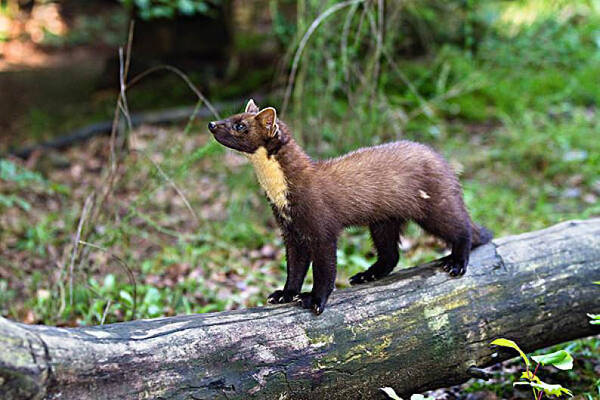Martes martes
IUCN
LCBasic Information
Scientific classification
- name:Martes martes
- Scientific Name:Martes martes,Pine Marten,Lin Diao
- Outline:Carnivora
- Family:mustelidae mustelinae marten
Vital signs
- length:46-54cm
- Weight:1-2.2kg
- lifetime:8-18years
Feature
A creamy white to yellow bib on the throat
Distribution and Habitat
Pine martens are found in Albania, Austria, Belarus, Belgium, Bosnia and Herzegovina, Bulgaria, Croatia, Czech Republic, Denmark, Estonia, Finland, France, Georgia, Germany, Greece, Hungary, Islamic Republic of Iran, Ireland, Italy, Latvia, Lithuania, Luxembourg, Liechtenstein, Macedonia, Moldova, Montenegro, Netherlands, Norway, Poland, Portugal, Romania, Russia, Serbia, Slovakia, Slovenia, Spain (introduced to the Balearic Islands), Sweden, Switzerland, Turkey, Ukraine, United Kingdom.
Pine martens live in areas with abundant vegetation, and prefer to live in coniferous and broad-leaved mixed forests and subarctic coniferous forests at an altitude of 800-1600 meters.
Appearance
The pine marten is a medium-sized carnivore, about the size of a domestic cat, with a head and body length of 46-54 cm, a tail length of 22-26 cm, and a weight of 1-2.2 kg. Male martens are slightly larger than female martens. Size varies with distribution area. Sexual dimorphism also occurs in size, with males being about 12-30% larger than females. There is a creamy white to yellow bib on the throat. The chest to lower abdomen are light gray, and the paws are dark. The tail is long, thick and fluffy. The fur of the pine marten is tough and soft, with fine and dense hair. It is thick and smooth in winter and short and rough in summer. The fur is light brown to dark brown, gradually becoming longer and lighter in winter. The pads on the bottom of the paws are completely covered with fur in winter. The cubs grow into the fur of the adult in the first winter after birth, and they will completely change their fur every spring. The fur growing period is from September to winter. The ears a
Details
Pine marten (scientific name: Martes martes) is a medium-sized carnivore, about the size of a domestic cat, with 8 subspecies.

Pine martens build nests in tree holes or shrubs. They are mainly active at night or dusk. Their claws can be semi-retracted, allowing them to live in trees. Tree holes are the preferred nesting site, and a family has several nests within the roosting range. In winter, the cold ambient temperature will abandon the tree nest and choose rock crevices as hiding places. Martens more frequently choose to roost underground.
Pine martens have a strong sense of territory, and mark their territory and range of activities with scent glands discharged from the abdomen and anus. Males will successfully defend their territory, and mating females also have a certain range of territories. The size of the family range varies greatly. Obviously, males have larger territories than females, and they will overlap with those of one or more females. However, the territories of males are usually non-overlapping. According to researchers' measurements, the average territory of males is 23 square kilometers, and that of females is 6.5 square kilometers. There are also estimates that male territories are only 2.2 square kilometers and female territories are 1.5 square kilometers. Seasonality has a strong influence on the range of most populations, with fall/winter ranges 8-54% smaller than spring/summer ranges. This range difference is also reflected in the distance covered by males at night, and ranges can overlap within high species densities.
Pine martens are omnivores, and the type of food they eat varies at different times of the year, depending on the seasonality of food sources. Diet composition and proportions often change according to season and local conditions. The breeding season is a unique de-ratification cycle for martens, when catches increase significantly, mainly voles. They have sharp teeth and eat small mammals, birds, insects, frogs, and carrion. In the fall, they eat strawberries, bird eggs, nuts, and honey. They are territorial and leave feces at their boundaries. Pine martens will chew plastic parts of vehicles to sharpen or clean their teeth.
Pine martens breed in February and March. The female gestation period is up to 7 months. Each litter has 1-5 pups. The pups weigh about 30 grams at birth and are blind and deaf. They can leave the nest completely independently at 6 months old. They reach sexual maturity at 2-3 years old. The life span of captive pine martens can reach 18 years old, while wild pine martens can only live to 8-10 years old.
Listed in the 2012 Red List of Endangered Species of the World Conservation Union (IUCN) ver 3.1 - Least Concern (LC).
Protect wild animals and eliminate game.
Maintaining ecological balance is everyone's responsibility!








